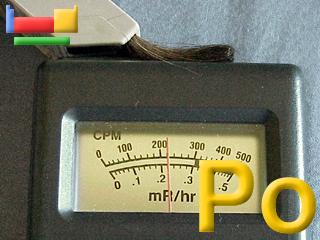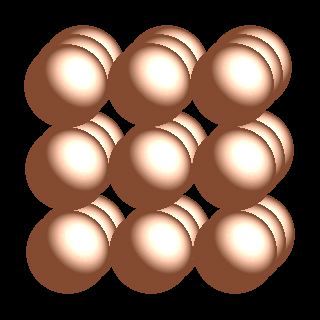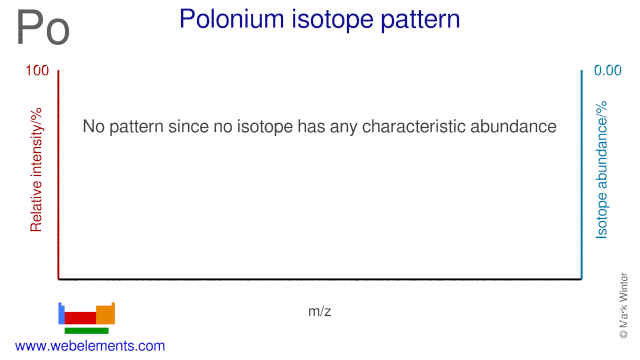Polonium - 84Po: the essentials
- Name: polonium
- Symbol: Po
- Atomic number: 84
- Relative atomic mass (Ar): [ 209 ] (longest lived isotope)
- Standard state: solid at 298 K
- Appearance: silvery
- Classification: Metallic
- Group in periodic table: 16
- Group name: Chalcogen
- Period in periodic table: 6
- Block in periodic table: p
- Shell structure: 2.8.18.32.18.6
- CAS Registry: 7440-08-6
Polonium atoms have 84 electrons and the shell structure is 2.8.18.32.18.6. The ground state electronic configuration of neutral polonium is [Xe].4f14.5d10.6s2.6p4 and the term symbol of polonium is 3P2.
Polonium: description
Polonium has more isotopes than any other element, all of which are radioactive. Polonium dissolves readily in dilute acids, but is only slightly soluble in alkalis.
Weight for weight it is about 2.5 x 1011 times as toxic as hydrocyanic acid (HCN). Polonium has been found in tobacco as a contaminant and in uranium ores.

Image adapted with permission from Prof James Marshall's (U. North Texas, USA) Walking Tour of the elements CD.
Polonium: physical properties
Density of solid: 9196 kg m-3
Molar volume: 22.97 cm3
Thermal conductivity: 20 (estimate) W m‑1 K‑1
Polonium: heat properties
Melting point: 527 [254 °C (489 °F)] K
Boiling point: 1235 [962 °C (1764 °F)] K
Enthalpy of fusion: 20.5 kJ mol-1
Polonium: atom sizes
Atomic radius (empirical): 190 pm
Molecular single bond covalent radius: 145 (coordination number 2) ppm
van der Waals radius: 293 ppm
Polonium: electronegativities
Pauling electronegativity: 2.0 (Pauling units)
Allred Rochow electronegativity: 1.76 (Pauling units)
Mulliken-Jaffe electronegativity: 2.48 (16.7% s orbital)
Polonium: orbital properties
First ionisation energy: 811.8 kJ mol‑1
Second ionisation energy: 1860 kJ mol‑1
Third ionisation energy: 2630 kJ mol‑1
Polonium: abundances
Universe: (no data) ppb by weight
Crustal rocks: (no data) ppb by weight
Human: (no data) ppb by weight
Polonium: crystal structure

Polonium: biological data
Human abundance by weight: (no data) ppb by weight
Polonium has no biological role.
Polonium: uses
Polonium: reactions
Reactions of polonium as the element with air, water, halogens, acids, and bases where known.
Polonium: binary compounds
Binary compounds with halogens (known as halides), oxygen (known as oxides), hydrogen (known as hydrides), and other compounds of polonium where known.
Polonium: compound properties
Bond strengths; lattice energies of polonium halides, hydrides, oxides (where known); and reduction potentials where known.
Polonium: history
Polonium was discovered by Marie Curie in 1898 at France. Origin of name: named after "Poland" (birthplace of Marie Curie).Polonium: isotopes

Polonium: isolation
Isolation: polonium is radioactive and excessivley rare in nature. It is made in very small qunatities through a nuclear reaction of bismuth. Neutron irradiation of 209bismuth (atomic number 83) gives 210polonium (atomic number 84).
209Bi + 1n → 210Po + e-
Metallic polonium can be fractionally distilled from the bismuth or electrodeposited onto a metal surface such as silver.
